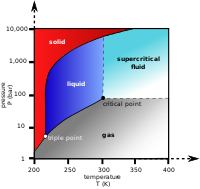
Photo from wikipedia
Abstract The present paper reports the results of analyses concerning heat transfer to supercritical pressure fluids, performed by adopting a k − e turbulence model modified in association with the AHFM model,… Click to show full abstract
Abstract The present paper reports the results of analyses concerning heat transfer to supercritical pressure fluids, performed by adopting a k − e turbulence model modified in association with the AHFM model, here used for calculating both buoyancy effects and the turbulent heat flux. The promising capabilities of this approach were already highlighted in past studies and the present paper represents a further step in this line of research. Experimental data concerning supercritical carbon dioxide flowing in tubes are here considered, with operating conditions involving both high and low mass flux values and spanning from relatively low inlet temperatures to values higher than the pseudocritical threshold. Some of the interesting features appearing in the experimental data are correctly reproduced by the model, which manages to predict reliable wall temperature trends, both qualitatively and quantitatively. The performed analyses, though reporting successes in a sufficiently wide range of operating conditions, suggest that some parameters of the proposed model should be varied in accordance with the boundary conditions, e.g. considering the mass flux, in order to improve predictions in the most challenging situations.
Journal Title: International Journal of Heat and Mass Transfer
Year Published: 2018
Link to full text (if available)
Share on Social Media: Sign Up to like & get
recommendations!